46 Texas Bugs and Insects (with Pictures) – Identification Guide
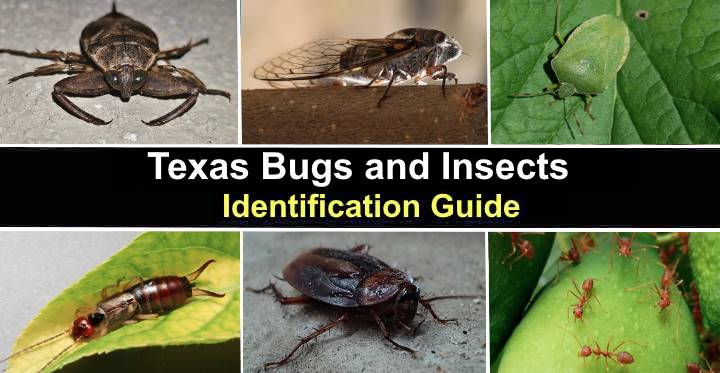
Texas is home to a diverse array of bugs and insects. The varied climate in Texas, hot and dry in the west and humid in the east, means that insects like ants, roaches, chiggers, beetles, and termites thrive. Also, many bugs in Texas, like bed bugs, stink bugs, and aphids can become nuisances in homes and gardens. Also, flying insects in Texas, like horseflies and mosquitoes, can give nasty bites and spread disease.
The Lone Star State is teeming with fascinating creepy crawlies. Knowing how to identify Texas bugs and insects is vital to ensure you can tell the difference between dangerous insects and beneficial ones. Proper bug identification also helps to know how to eliminate potentially harmful insects.
Texas is known for its vast landscapes and varied ecosystems, making it a haven for a wide range of bugs and insects. From the scorpions lurking in the desert to the fire ants marching across the plains, Texas bugs and insects play a vital role in the state’s ecosystem.
This article delves into the fascinating world of Texas bugs and insects. You will learn about their identifying characteristics, where to find them, and how they benefit the environment.
Texas Bugs vs. Insects
In Texas, people often use the word “bugs” to refer to any annoying insect. However, only insects in the order Hemiptera are classified as true bugs. These small creatures are identified by piercing and sucking mouthparts (proboscis) they use to suck plant sap. Like all insects, bugs have six legs.
On the other hand, the class of insects (Insecta) is wider than the order of bugs (Hemiptera). Insects are identified by their size, antennae, six legs, wing structure, and distinctive markings. Therefore, all bugs are classified as insects; however, not all insects are bugs in the scientific sense.
This article identifies various types of Texas bugs and insects. It refers to all types of annoying insects, arthropods, and arachnids as bugs, whether they are true bugs or not.
Types of Texas Bugs (with Pictures) – Identification Guide
Let’s look in detail at some of the most common Texas bugs you are likely to find in your home or yard.
Bed Bugs (Cimex)

Bed bugs are small, oval-shaped, blood-sucking insects that are reddish-brown. Bed bugs are about the size of an apple seed, measuring 0.19” to 0.27” (5 – 7 mm). The tiny wingless creatures have six legs, piercing-sucking mouthparts for feeding on blood, six legs, and a red color after feeding.
Bed bugs often lurk in the crevices of beds, mattresses, and furniture. They are active at night, feeding on the blood of humans and animals. The tell-tale signs of bed bugs are the itchy red marks their bites cause. Because the tiny critters are so small, they are difficult to eliminate without professional pest control treatment.
Other signs of a bed bug infestation include a sweet, musty odor, dark reddish-brown pepper-like stains (feces), and molted bodies.
Texas Bug Identification: Bed bugs are minuscule reddish-brown insects with oval-shaped, flat bodies and measure around 0.19” (5 mm) long.
Southern Green Stink Bug (Nezara viridula)
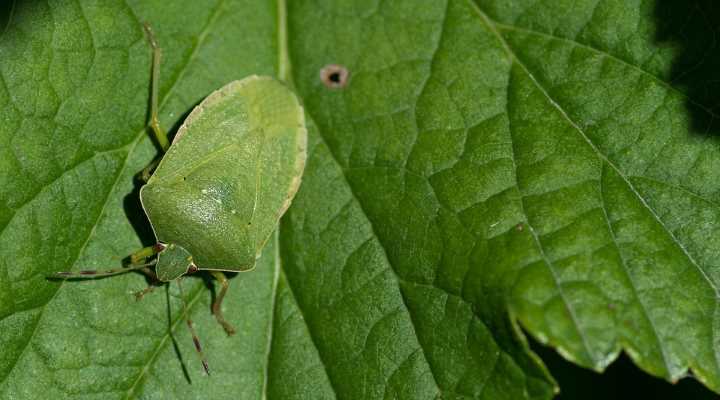
The southern green stink bug is a small bright green insect with a shield-shaped body. Commonly found in backyards in Texas, the bug has a distinct triangular shape and measures 0.48” (12 mm) long. The green bug has six legs, reddish eyes, and long tan-brown antennae.
The green stink bug gets its name from the foul-smelling odor it releases when threatened or crushed.
The southern green bug goes through several color changes in its growth stages (instars). It can be black with rows of creamy-white spots, have an orange back, or turn brown in winter. Stink bugs can also damage crops.
These green bugs are considered agricultural pests as they feed on various crops, including fruits, vegetables, and grains. They use their proboscis to pierce plant tissue and suck out the juices, causing damage to the crops.
Other common species of stink bugs in Texas include the following:
Harlequin bug (Murgantia histrionica): A black bug with brilliantly marked orange or yellow markings.
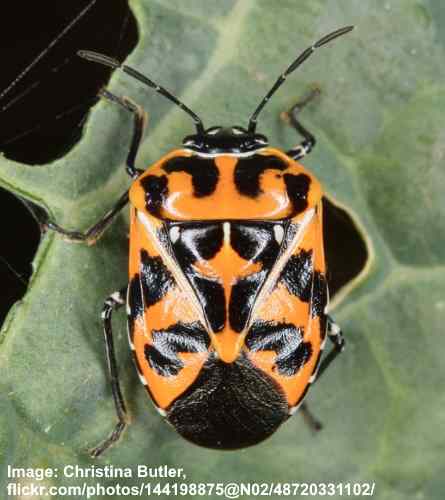
Harlequin bug (Murgantia histrionica)
Conchuela stink bug (Chlorochroa ligata): A black shield-shaped bug with red speckles on its back and a red margin.

Conchuela stink bug (Chlorochroa ligata)
Rice stink bug (Oebalus pugnax): A pale brown colored flying bug with an identifiable triangular marking on its back.
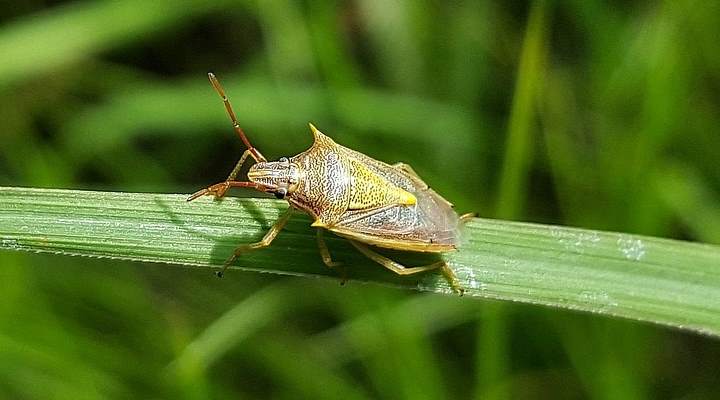
Rice stink bug (Oebalus pugnax)
Spined soldier stink bug (Podisus maculiventris): The brown-greenish stink bug is classified as a beneficial insect because it preys on the larvae of common crop pests.
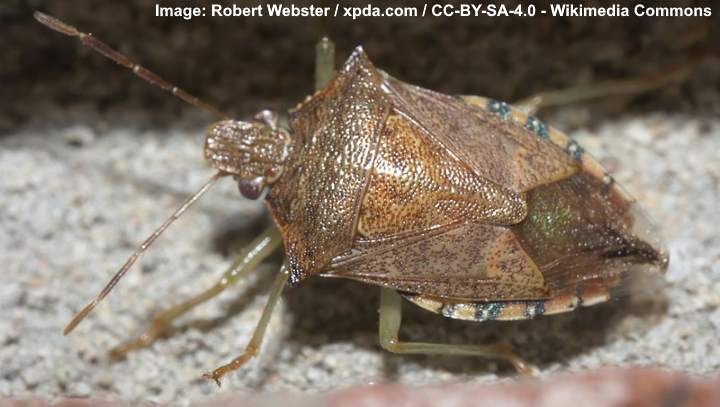
Spined soldier stink bug (Podisus maculiventris)
Texas Bug Identification: To find stink bugs in a Texas landscape, look for their distinctive shield-shaped body and distinctive triangular pattern on their back.
Dog-Day Cicada (Neotibicen canicularis)
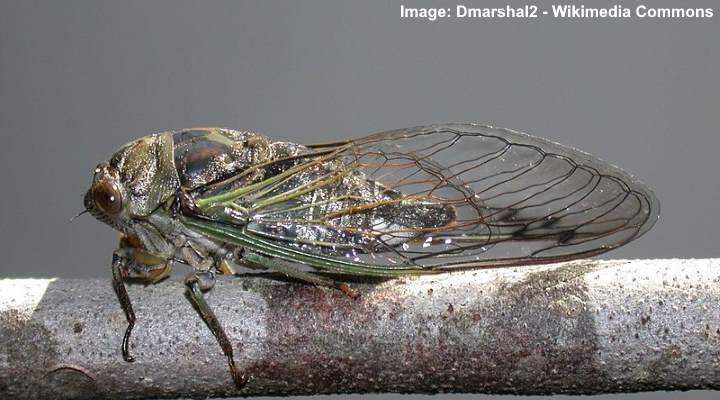
The dog-day cicada is a large dark bug identified by its greenish head, bulging eyes, and mottled patterns on its back. This common Texas bug has green, black, brown, and white body markings. It also has transparent wings, large, robust legs, and measures 1.06” to 1.30” (27 – 33 mm) long.
A characteristic of the dog-day cicada is its loud buzzing and distinctive mating calls. In flight, it creates a high-pitched whining sound like a power saw cutting wood. It is most active on hot, humid summer days.
Texas Bug Identification: The dog-day cicada is a dark-bodied insect with huge transparent wings and dark green or brown markings.
Giant Water Bugs (Belostomatidae)
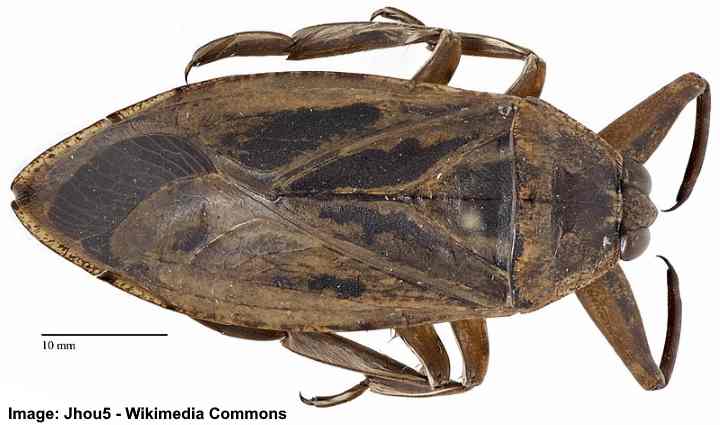
Giant water bugs are large insects with an oval shape, flattened brown bodies, and a length of approximately 2 inches (50 mm). One distinguishing characteristic of these large aquatic insects is their notably large front legs, which they employ to capture and secure prey. Their four hind legs, on the other hand, are primarily used for swimming underwater.
Giant water bugs also go by the names Texas toe-biters, alligator ticks, and electric-light bugs. In Florida, the large bugs are called alligator fleas. As the common names suggest, the large bugs use their pincers to cause a painful bite when threatened. However, the bugs are not harmful to humans.
Texas Bug Identification: To identify giant Texas water bugs, look for their large size, dark brown or black color, flat oval shape, and long legs. You can commonly find the bugs in streams, ponds, and other freshwater habitats.
Aphids (Aphidoidea)

Aphids are common tiny bugs in Texas, measuring about 0.12 inches (3 mm) in length. These pesky insects feed on greenhouse crops, shrubs, and houseplants throughout Texas. The minuscule insects are identified by their pear-shaped bodies, six legs, and long antennae. Aphids are true bugs and are typically found in various colors, including green, yellow, red, or black.
Woolly aphids are another type of plant-destroying sap-sucking insect. These tiny creatures are easy to identify by their white, fuzzy appearance.
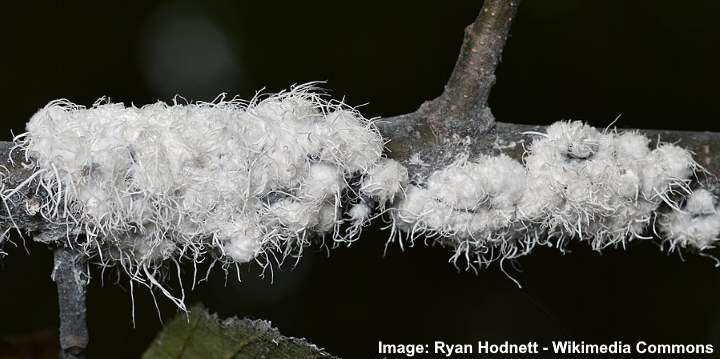
Woolly aphids infestation
Aphids are a pest in gardens, greenhouses, and homes because they reproduce quickly and can infest plants in large numbers. The bugs bite into leaves, stems, and flowers, weakening the plant’s health. They also damage plants by secreting a sticky substance called honeydew, which promotes mold growth.
Texas Bug Identification: Aphids are tiny bugs that measure 0.08” to 0.12” (2 – 3 mm) long. They are identified by their soft bodies and pear-shaped appearance. Aphids are often found in clusters on the undersides of leaves.
Related reading: How to kill aphids.
Kissing Bugs (Triatoma gerstaeckeri)
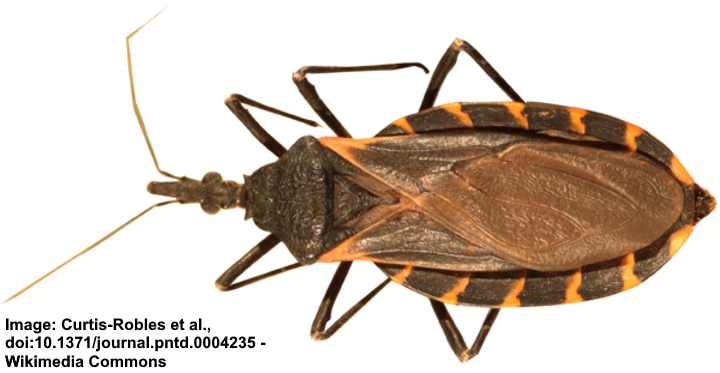
Triatoma gerstaeckeri (in the picture) is the most common species of kissing bug in Texas
Kissing bugs are common blood-sucking Texas insects with blackish-brown bodies and yellow or orange markings on their wing covers (elytra). The small disease-carrying bugs have an oval shape and thin proboscis they use to feed on the blood. Adult kissing bugs measure 0.79” to 1.18” (20 – 30 mm) long.
Kissing bugs are known to transmit the parasite Trypanosoma cruzi, which causes Chagas disease. It’s important to prevent the bugs from entering your home by caulking gaps around doors and windows and using insect screens.
The CDC recommends you avoid touching or squashing kissing bugs. Instead, capture the bug in a container and take it to a health department or local extension service.
Texas Bug Identification: Kissing bugs are identified by their brown, oval bodies with orange or yellow stripes around the edges of their abdomen.
Types of Texas Insects
Let’s look in detail at common Texas insects that many people call pesky bugs.
Cockroaches (Blattaria)

German roach (Blattella germanica) on the left and American roach (Periplaneta americana) on the right
Cockroaches are a group of insects known for their reddish-brown or dark brown flattened bodies, long antennae, and rapid movements. Often called roaches, species of cockroaches in Texas measure 0.43” to 1.6” (11 – 40 mm) long. The nasty bugs usually lurk in dark crevices, infesting homes and spreading diseases.
The hot, dry, and sometimes humid climate in Texas means that roaches can become a problem in homes. The brown bugs search for dark, damp places near food sources where they can feed and reproduce. Some cockroaches in Texas can also fly.
Here are descriptions and identifying features of the three most common species of roach bugs in Texas:
American Cockroach (Periplaneta americana)
The American cockroach is a common brown bug in Texas measuring 1.5” to 2” (38 – 50 mm) long. It is recognized by its flat, oval body, exceedingly long antennae, and fast, darting movements. The reddish-brown roach can also fly short distances. It’s one of the largest cockroaches you can find in Texas.
German Cockroach (Blattella germanica)
The most common small roach in Texas is the German cockroach. Also called the croton bug, the small tan to dark brown bug grows 0.43” to 0.66” (11 – 16 mm) long. Identifying features of the brown insect are its parallel stripes running behind its head, long antennae, and small brown head. The cockroaches survive outdoors and indoors in Texas.
Oriental Cockroach (Blatta orientalis)
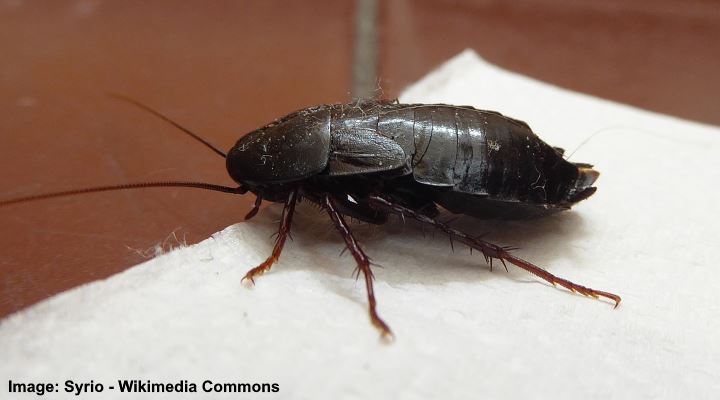
The Oriental cockroach, also called the black cockroach, is a large black bug measuring 0.71” to 1.14” (18 – 29 mm) in length. The adult cockroaches have an oval shape and shiny body. Although they have wings, the disease-carrying bugs cannot fly. You usually find the bugs infesting moist, dark places and are difficult to eradicate.
Palmetto Bug (Eurycotis floridana)
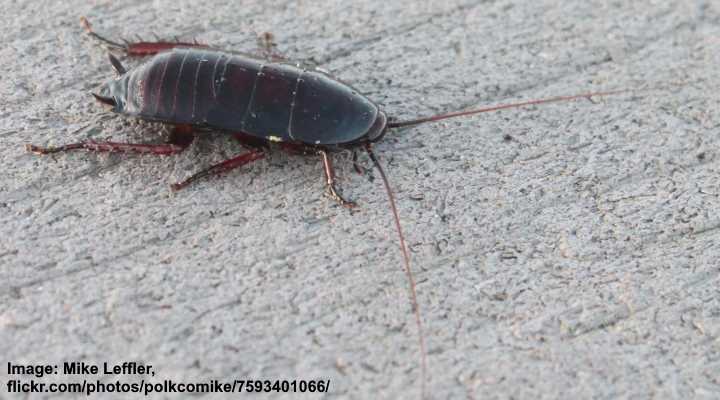
The palmetto bug is identified as a large, reddish-brown cockroach insect commonly found in Texas. Also called the Florida wood cockroach, the identifying features of the bug are its short forewings, large size of up to 1.6” (40 mm) long, and its ability to fly. The dark brown bug is often attracted to warm, humid environments.
Unlike other disease-carrying roaches, the palmetto bug isn’t a significant pest indoors. The dark brown, glossy roaches prefer to live outdoors in Texas landscapes. You may find it under leaf litter, in bushes, or lurking in crevices. It may sometimes get into homes and bathrooms in cooler parts of Texas.
Texas Insect Identification: The palmetto bug is a large reddish-brown or blackish-brown cockroach with a shiny, oval-shaped body, long antennae, and six legs. It is commonly found in warm and humid areas.
Tawny Crazy Ant (Nylanderia fulva)
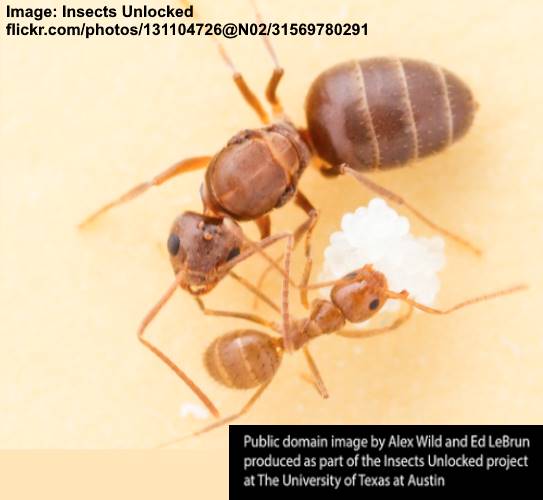
Tawny crazy ants: a queen and worker ant
The tawny crazy ant is a small reddish-brown invasive species that can fly. Also called the raspberry crazy ant, the pesky insects are identified by their slender bodies, long, slender legs, and bulbous abdomen. The pale brown ants grow 0.12” (3 mm) long. They get their name from their erratic and fast movements, which appear “crazy.”
Tawny crazy ants can bite and release formic acid as a defensive mechanism. They can quickly infest and take over an area, making enjoying time in affected yards difficult. They also are attracted to electrical equipment and chew through wires, creating short circuits.
Texas Insect Identification: Identifying features of the tawny crazy ant are its small size up to 0.12” (3 mm) long, reddish-brown color, and fast, erratic movements as it forages for food.
Fire Ants (Solenopsis)
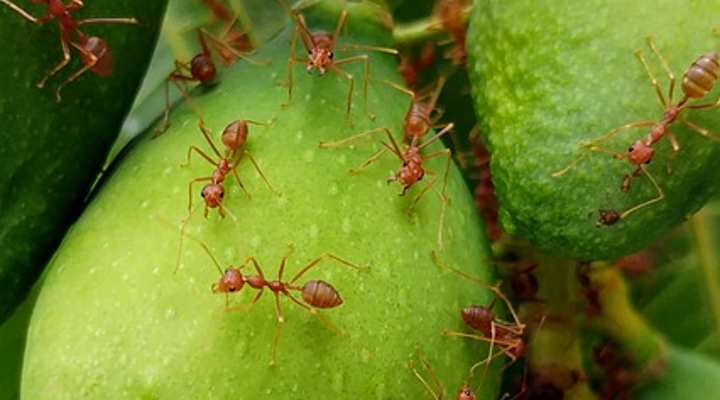
Fire ants are small reddish-brown stinging ants known for aggressive behavior and painful sting. The small pesky insects are identified by a rounded head and abdomen and a slender two-segmented waist. The ants typically grow 0.09” to 0.23” (2.24 – 6 mm) and are commonly found in the southern United States, including Texas.
Fire ants build large mounds and can be a nuisance in yards, parks, and agricultural areas. They sting humans by biting into the skin and injecting toxic venom with their stingers. Fire ant stings are exceedingly painful and can result in severe swelling, nausea, and vomiting.
Texas Insect Identification: Fire ants are identified by reddish-brown to reddish-black coloration, segmented body with a two-segmented waist, and painful stings when provoked.
Fleas (Siphonaptera)
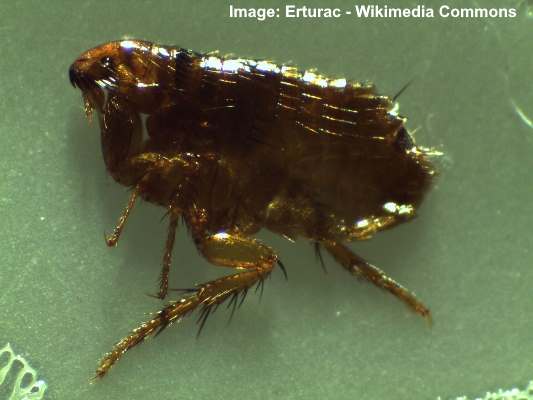
A close up picture of a flea (35x zoom optical microscope)
Fleas are small, wingless parasitic insects that feed on blood and can jump long distances. Fleas are typically dark brown or black, with a pear-shaped flattened body and long hind legs for jumping. However, the tiny bugs are so small that you need a microscope to see their identifying features.
Tiny fleas grow 0.12” (3 mm) long. Besides being excellent jumpers, the bugs can quickly move through fur or hair. The insect bites can cause itchy red bumps on the skin. Additionally, flea bites can transmit bacterial diseases and worms.
In Texas, fleas are a common pest due to the warm climate and abundance of animals. It is important to take preventative measures, such as regularly treating pets for fleas and keeping outdoor areas clean to reduce the risk of infestation.
Texas Insect Identification: Fleas are identified by their dark brown or black, tiny pear-shaped flattened body, and long hind legs for jumping.
Chiggers (Trombiculidae)
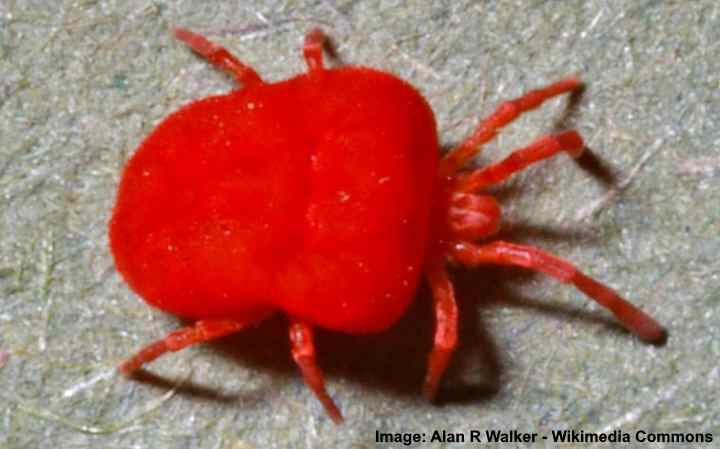
A close up image of a chigger
Chiggers are tiny red biting mites, so small they are barely visible to the naked eye. Chiggers are not insects; instead, they are a type of red-colored arachnid. The minuscule bugs measure 0.01” (0.4 mm) and have a round body and eight legs. They are known for feeding on and biting skin, leaving itchy red bite marks.
Chiggers are active during hot and humid months in Texas. They cause pain by piercing skin with their sharp mouthparts and injecting an enzyme that disintegrates skin. This results in a red rash, swelling, and secondary skin infections from scratching.
The two annoying chigger species in Texas are the following:
The common chigger (Trombicula alfreddugesi) inhabits grasslands, brush areas, and undergrowth.
Eutrombicula splendens is a tiny biting mite in bogs, swamps, and marshy areas.
Texas Insect Identification: Chiggers are microscopic and hard to spot with the naked eye. The best way to identify chiggers is by the itchy rash and red welts their “bites” cause.
Carpet Beetles (Anthrenus and Attagenus)
Carpet beetles are small, oval-shaped insects that commonly infest homes in Texas. The adult beetles measure between 0.06” and 1.25” (1.5 – 3 mm). They are typically dark gray or black with mottled white, brown, and black patterns on their elytra. Carpet beetles are pesky bugs in their larvae stage because they chew carpets, clothing, and other soft household items.
Carpet beetle larvae are small, hairy, worm-like creatures often called “woolly bears.” They can range in color from white to brown and are covered in bristle-like hairs. The larvae feed on natural fibers, such as wool, silk, and fur, as well as feathers and dead insects. If left untreated, they can cause significant damage to carpets, upholstery, and clothing.
Here are the identification features of three types of carpet beetle bugs that infest homes in Texas.
Varied Carpet Beetle (Anthrenus verbasci)
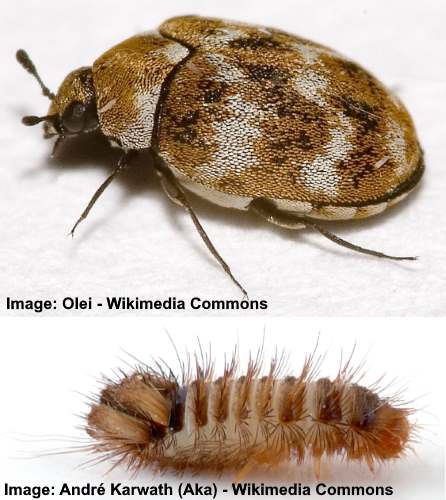
Varied carpet beetle (top image) and larva (bottom image)
The varied carpet beetle is identified as a small, round “bug” known for its mottled color patterns of black, brown, and white scales. It measures 1.25” (3 mm) long, with an oval body shape. The beetle larvae are covered in bristle-like hairs. They are destructive household pests, feeding on natural fibers like wool, fur, and carpets.
Common Carpet Beetle (Anthrenus scrophulariae)
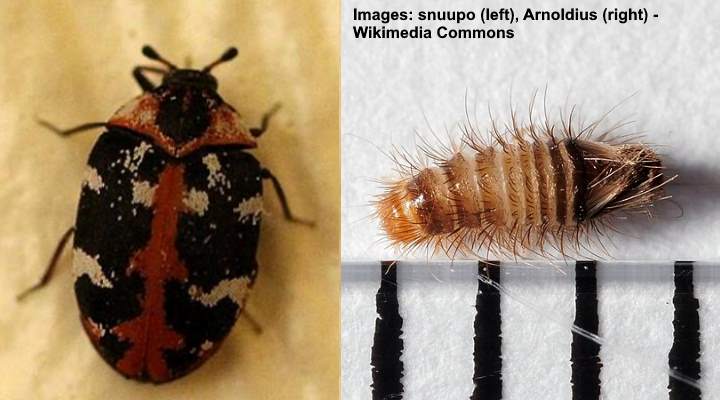
Common carpet beetle adult and larva
The common carpet beetle is a small, oval-shaped black insect measuring 0.15” (3.8 mm) long. Its identifiable features are its black elytra with orange or red speckled patterns. Like all carpet beetle larvae, it’s a destructive household bug that damages natural fibers, textiles, and stored food products.
Furniture Carpet Beetle (Anthrenus flavipes)
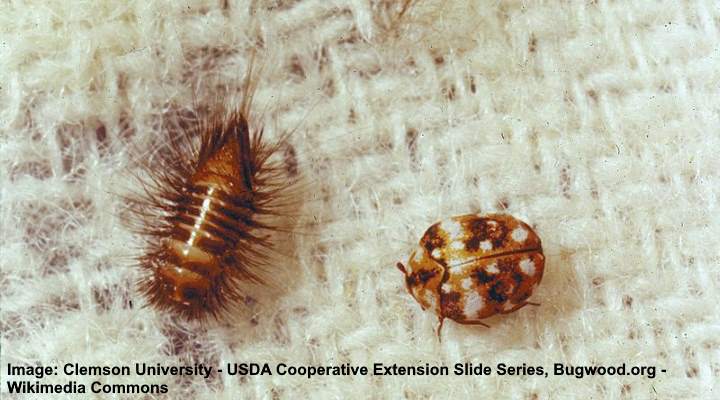
Anthrenus flavipes larva and adult on woolen cloth
The furniture carpet beetle is a small, oval-shaped beetle with a pattern of yellow, black, brown, and white scales on its wing covers. The adult beetle measures 0.08” to 0.14” (2 to 3.5 mm) long. The beetle larvae feed on carpets, cotton, linen, leather, and dry cheeses.
Cigarette Beetles (Lasioderma serricorne)
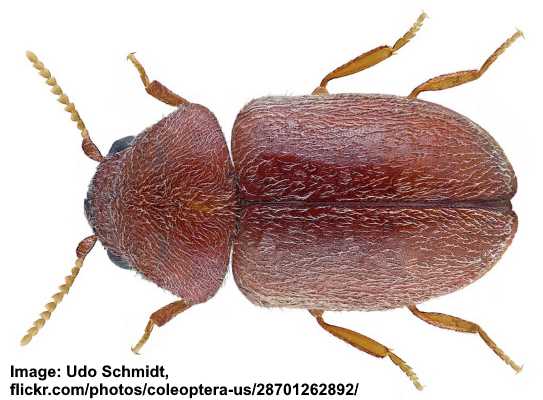
Cigarette beetles are identified as small brown insects with oval body covered in fine hairs, a distinct humpbacked shape and clubbed antennae. The brown beetles measure 0.08” to 0.11” (2 – 3 mm) long. The small brown beetles look like drugstore beetles, and the pesky bugs primarily infest tobacco plants.
Cigarette beetles and drugstore beetles can also become pantry pests in Texas if they get into cupboards. The minuscule bugs feed on stored cereals, dried fruit, grains, spices, and flour.
Texas Insect Identification: To identify cigarette beetles, look for their reddish-brown color, humpbacked shape, and clubbed antennae.
Earwigs (Dermaptera)
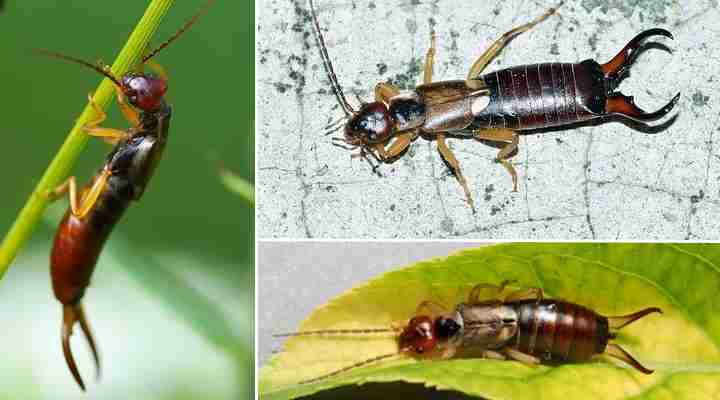
Earwigs are small, elongated black pests with distinctive forcep-like appendages at the end of their abdomen. These slender bugs are easily recognizable by their dark, flattened bodies, tail pincers, and long segmented antennae. The nocturnal insects are commonly found in damp areas such as under rocks, logs, or garden mulch.
Earwigs measure 1” (25 mm) long and are active at night. During the day, they stay in dark places. At night, they feed on other insects, including aphids and mites. Indoors, they search out sweet, greasy, and oily foods. Earwigs are nuisance pests and are not harmful to humans.
Texas Insect Identification: Earwigs are easily recognizable bugs with elongated bodies, pincer-like cerci, and membranous wings folded beneath short, leathery forewings.
Further reading: Earwigs: Damage, Identification, and Control.
Silverfish (Lespisma saccahrina)
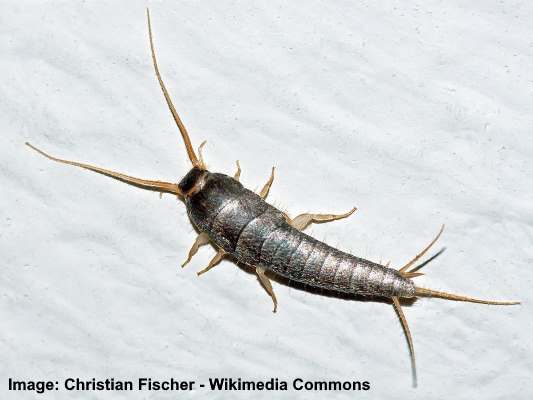
Silverfish is a small, wingless insect with an elongated body covered in silvery-gray scales. The silvery bug measures 0.5” to 1” (13 – 25 mm) long. It’s identified by three slender appendages at its tail end and two long antennae on the front of its body. The bug has a shiny, scaly appearance and slithers across floors.
Silverfish are commonly found in damp areas such as bathrooms, kitchens, and basements. It gets its name from its color and fish-like movements as it scurries to avoid light and find dark places. The harmless bugs are nuisance pests due to their ability to damage paper goods, stain clothing, or contaminate food.
Texas Insect Identification: Silverfish is identified by its carrot-shaped body covered in silver-gray scales, two long antennae, and three tail-like appendages at its rear. Its rapid, wriggling movements make it easy to spot.
Jamaican Field Cricket (Gryllus assimilis)
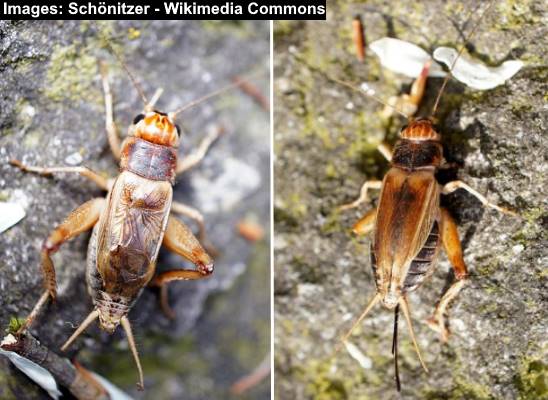
Jamaican field cricket male (left) and female (right)
The black field cricket is a common insect found in gardens in southern Texas. It is identified by its dark brown and reddish-brown coloring, rounded orange head with two black eyes, and large size, measuring up to 1” (25 mm) long. Male crickets make rapid chirping sounds.
Jamaican field crickets can become a problem when large outbreaks occur in August and September. Large piles of dead crickets can accumulate on sidewalks that look unsightly and emit foul odors. Sometimes, they can become a nuisance pest indoors. They can damage drapes, clothing, or wall covering with their feces.
Texas Insect Identification: The Jamaican field cricket is common in southern areas of the Lone Star State and is identified by its dark colors, long antennae, and prominent hind legs.
Termites (Isoptera)

Termites are small, white to grayish-white destructive insects that live in colonies and feed on wood. The small, ant-like bugs have a slender, soft body measuring 0.37” (9.5 mm) long. They are identified by their straight antennae, thick waist, and straight, bead-like segments on their abdomen.
Termite pests in Texas can be subterranean insects (Rhinotermitidae) or dry-wood termites (Kalotermitidae).
Subterranean termites create nests in the ground and cause the most damage. The destructive bugs can cause unseen damage to wood structures as they feed on wood, paper, and other plant materials. They can be found throughout Texas.
Dry-wood termites are typically found in coastal areas in Texas and as far north as San Antonio. Like their subterranean counterparts, dry-wood termites can cause tremendous damage to wooden structures.
Types of Flying Insects in Texas
Some of the peskiest bugs in Texas are flying insects that can sting, bite, or invade pantries. Here are some of the most common flying bugs in Texas.
Mosquitoes (Culicidae)
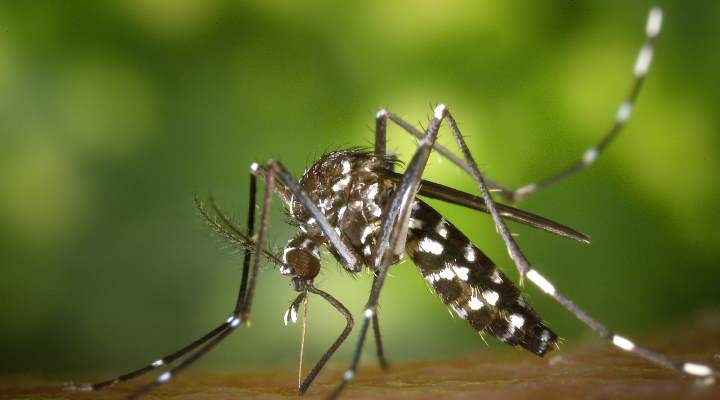
The Asian tiger mosquito (Aedes albopictus)
Several species of mosquitoes are flying pests and are prevalent throughout the Lone Star State. The biting bugs have slender bodies, long legs, and long mouthparts called proboscis. The small flying insects grow to 0.39” (10 mm) long. Female mosquitoes feed on human and animal blood, whereas the males feed on plant nectar.
The most common genera of mosquitoes in Texas are Aedes, Culex, and Anopheles. For example, the Asian tiger mosquito (Aedes albopictus) is widespread in the south. It’s easily recognizable as a black flying bug with white stripes on its legs and aggressive biting behavior.
Texas flying insect identification: Mosquitoes are identified by their small size, long proboscis for sucking blood, and buzzing noise near your ear.
Horse Flies (Tabanidae)
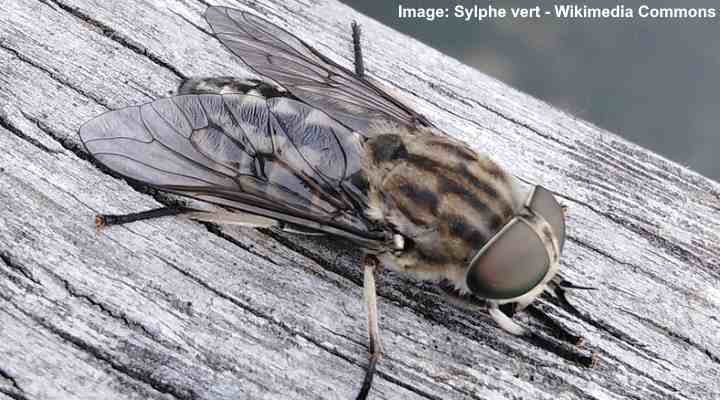
Horse flies are large, robust flies known for their painful bites. The flying insects are common in Texas and are identified by their dark brown or black coloration, large compound eyes, and stout bodies with short antennae. The strong fliers measure between 0.20” and 1” (5 – 25 mm) long.
Horse flies are often found near bodies of water or in rural areas with livestock. Female horse flies deliver a painful bite as they seek blood meals. These bites can lead to swelling, itching, and discomfort. Horse flies are known to bite both humans and animals, including horses, cattle, and deer.
Texas Flying Insect Identification: Horse flies in Texas can vary in appearance and species. Many species have iridescent or metallic color patterns. They measure up to 1” (25 mm) long.
Indian Meal Moth (Pantry Moths) (Plodia interpunctella)
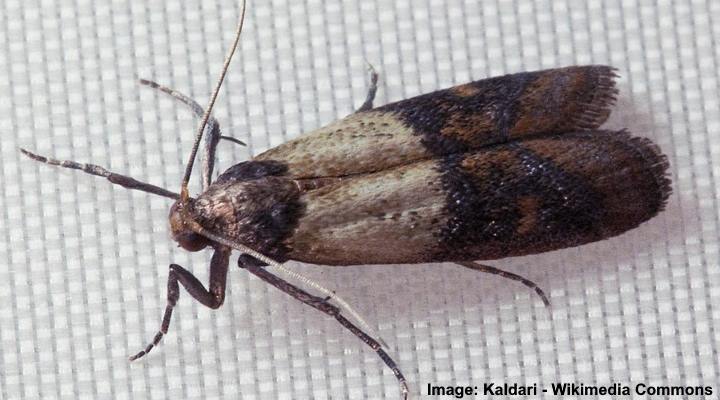
The Indian meal moth is a common pantry bug with two-toned gray-beige and dark brown wings. This small pesky brown and gray moth measures 0.39” (10 mm) with a wingspan of 0.6” to 0.79” (16 – 20 mm). Indian meal moth larvae are tiny and usually infest stored grains, cereals, pasta, rice, and flour.
You often see Indian meal moths flying in kitchens, food storage cupboards, and pantries. Signs of larvae-infested food include silken web-like strands in food packets, cast skins, or pepper-like spots (feces).
Texas Flying Insect Identification: Identification features of the Indian meal moth are its distinctive creamy-gray forewings with coppery-brown wingtips and gray hindwings.
Fruit Flies (Drosophila melanogaster)

Fruit flies are tiny nuisance flies with tan or light brown bodies, red eyes, small translucent wings, and black bands across their abdomens. Tiny fruit flies only measure 0.10” (2.5 mm) long. These small brown flies are common in Texas homes in summer, hovering over ripe or decaying fruits.
Fruit flies are not dangerous and don’t spread disease. However, a large infestation in the house can become annoying. Store fruit and vegetables in the refrigerator or airtight containers to get rid of the flying pests. Also, dispose of overripe or rotting fruit in the outdoor trash can and keep kitchen surfaces clean.
Texas Flying Insect Identification: Fruit flies are easily recognizable by their small size, tan or light brown body, and red eyes. They are commonly found around fruits and can be a nuisance in kitchens and grocery stores.
Drain Flies (Psychodidae)
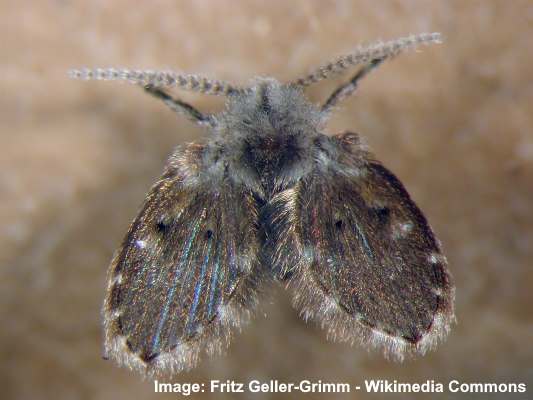
Drain flies are small, flying, pesky insects with gray fuzzy bodies and arching antennae. The adult furry moth-like flies measure 0.12” (3.1 mm) and appear near drains, sewage systems, and other damp areas. Their larvae live in the slimy sludge in drainage systems in bathroom and kitchen sinks.
Drain flies are also called sewer flies, sewer gnats, filter flies, or sink flies. Getting rid of the annoying flies is challenging because the larvae are aquatic and live in drains. You can try pouring boiling water into the drains to kill larvae.
For an easy drain cleaner, mix half a cup of salt and half a cup of baking soda and pour into the drain. Then, pour in a cup of white vinegar. Leave overnight and then rinse with boiling water the next morning to kill fly larvae and eggs.
Texas Flying Insect Identification: Drain flies are annoying moth-like insects with a gray, fuzzy appearance and segmented antennae commonly found near drains and sinks.
Gnats (Nematocera)
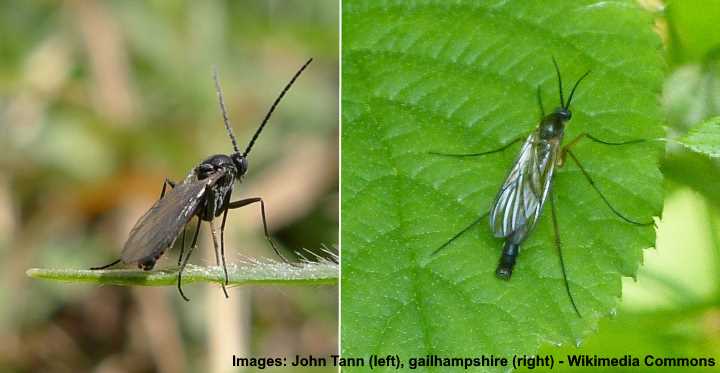
Fungus gnats (soil gnats) are soil dwelling small black houseplant pests that feed on fungus
Texas is home to various species of gnats—small flying insects with long, slender bodies and narrow wings. Some species of gnats, like buffalo gnats and eye gnats, can bite, causing red, itchy bumps on the skin. Other species, like fungus gnats, typically live in houseplant soil and are a nuisance.
Here are common species of gnats commonly found throughout Texas:
Buffalo gnats: Tiny black biting flies common near streams and rivers. They grow up to 0.12” (3.1 mm) long.
Fungus gnats: Small, slender black flies that typically infest homes. They are so tiny the flies are easy to mistake for fruit flies. Find out how to get rid of fungus gnats from houseplants.
Eye gnats: These biting gnats tend to fly around the eyes, mouth, and nose. They can cause infections like pink eye.
Other Types of Texas ‘Bugs’
Many other small creatures in Texas are referred to as bugs, even though they are not classified as insects or bugs in the true sense of the word.
Lone Star Tick (Amblyomma americanum)
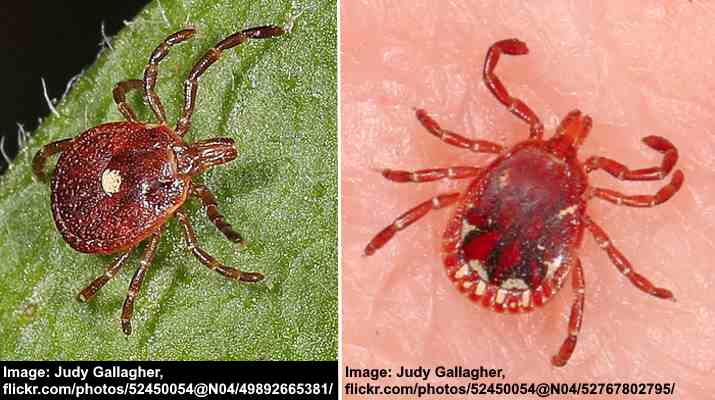
Lone Star ticks: female (left) and male (right)
The Lone Star tick is a common tick species found in Texas.
The ticks are reddish-brown and have oval bodies with a prominent silvery-white spot on the female’s backs. The male ticks have white markings around the margins of their backs. They can measure 0.33” (8.4 mm) long. Like many species of ticks in Texas, they pierce skin to engorge themselves on a blood meal. At the same time, the nasty bugs transmit diseases such as Lyme disease.
Other species of ticks in Texas include the following:
Deer ticks (Ixodes scapularis): The tiny male tick is smaller and black, whereas the female is black and brown.

Deer ticks: male (left) and female (right)
American dog ticks (Dermacentor variabilis): These nasty creatures are brown with whitish markings and are also called wood ticks.
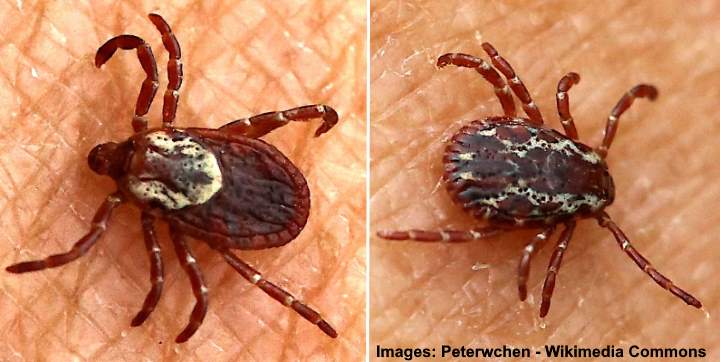
American dog ticks: female (left) and male (right)
Texas Redheaded Centipede (Scolopendra heros)
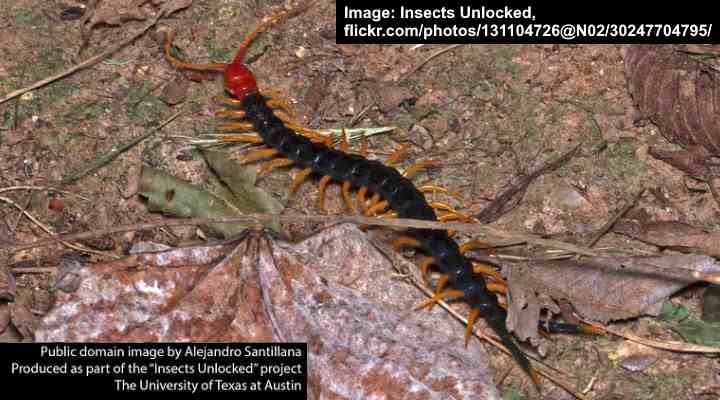
The Texas redheaded centipede is a large arthropod with a long greenish-black body, a distinctive dark orange-reddish head, and pale orange legs. The large centipede grows up to 6.5” (170 mm), sometimes even longer. The venomous creature can bite humans, causing localized swelling, redness, and intense pain.
Texas Bug Identification: To identify the Texas redheaded centipede, look for its dark black-green body, red head, and numerous pairs of orange legs.
Striped Bark Scorpion (Centruroides vittatus)
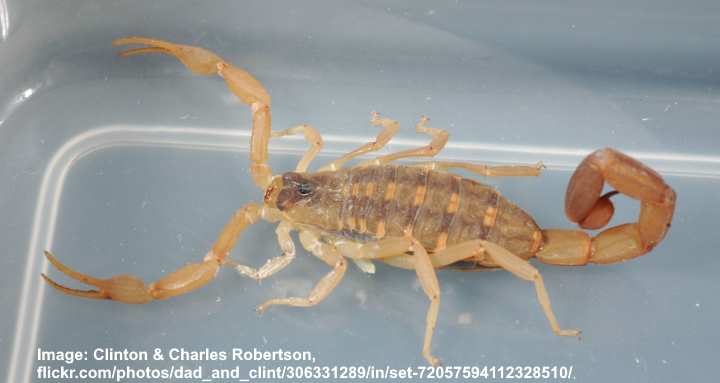
The striped bark scorpion is a pale yellow arthropod with two longitudinal dark stripes on its back. This yellowish scorpion is commonly found in the dry, arid regions of Texas and measures 2.5 to 3 inches (63 – 76 mm) in length. These stinging scorpions sometimes enter homes and are capable of delivering a painful sting.
Texas Bug Identification: The small native scorpion has identifiable dark stripes on its pale orange or yellow body and a triangular mark near its head.
Pillbugs (Armadillidium vulgare)
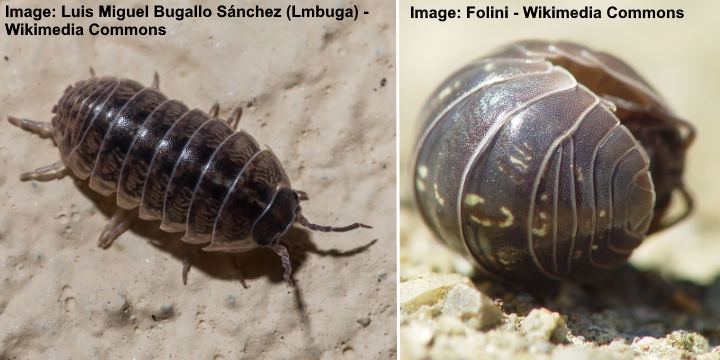
Pillbugs, known as roly-polies or woodlice, are small grayish-black crustaceans with armored bodies measuring approximately 0.70 inches (18 mm) in length. These easily identifiable bugs have segmented, oval-shaped bodies and seven pairs of legs. Their distinctive characteristic is their ability to roll into a ball when threatened. Pillbugs are commonly found under fallen leaves, rocks, and mulch.
Pillbugs grow 0.25” to 0.5” (6 – 12 mm) long. The grayish bugs love dark places and feed on decomposing plant leaves and other decaying organic material. They can also be minor pests in gardens where the gray bugs can feed on plant roots and foliage.
Sometimes, pillbugs can become a pest inside the home, where they tend to congregate in damp, dark areas. However, the bugs don’t cause damage and are only a nuisance.
Texas Bug Identification: Pillbugs can be identified by their oval shape, segmented dark body, and ability to roll into a ball.
Spiders
Spiders are not insects, but many people refer to them as bugs because of their annoyance. Spiders are arachnids, identified by their eight legs, two body segments, and no antennae. They also have multiple eyes and large mandibles they use for biting their prey. Common species of spiders in Texas include the following:
- Black widow spider (Latrodectus mactans)
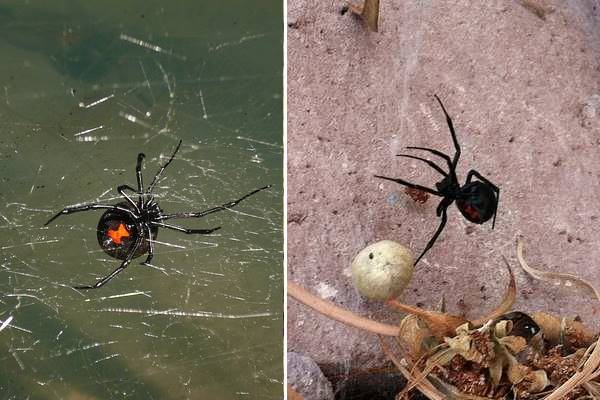
Black widow spider (Latrodectus mactans)
- Brown recluse spider (Latrodectus)
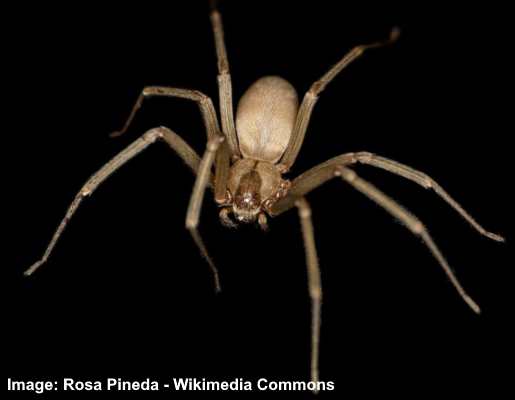
Brown recluse spider (Loxosceles reclusa)
- Long-bodied cellar spider (Pholcus phalangioides)
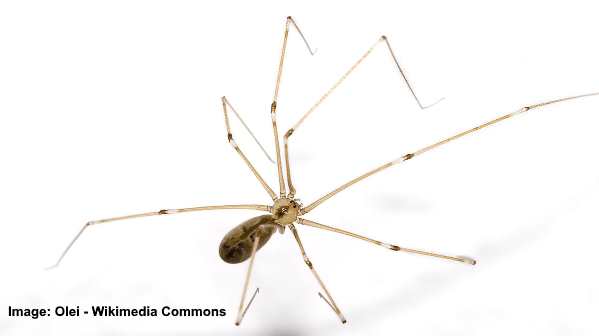
Long-bodied cellar spider (Pholcus phalangioides)
- Common house spider (Parasteatoda tepidariorum)
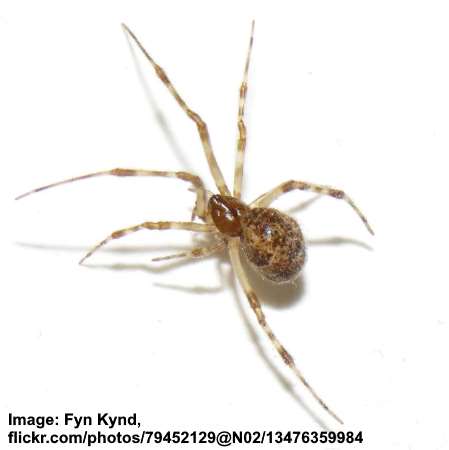
Common house spider (Parasteatoda tepidariorum)
- Crab spiders (Thomisidae)
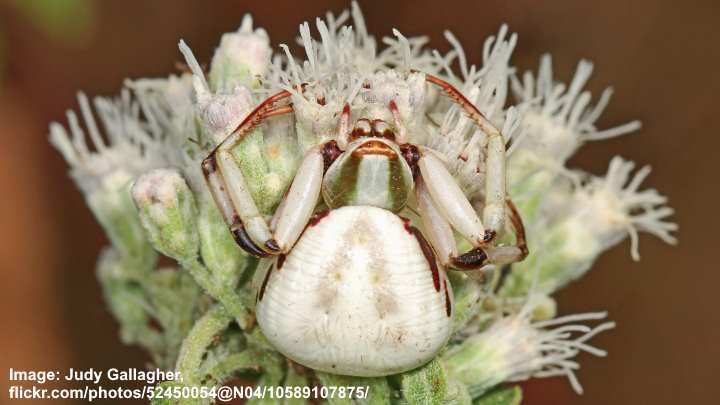
White-banded crab spider (Misumenoides formosipes)
- Woodlouse hunter spider (Dysderidae)
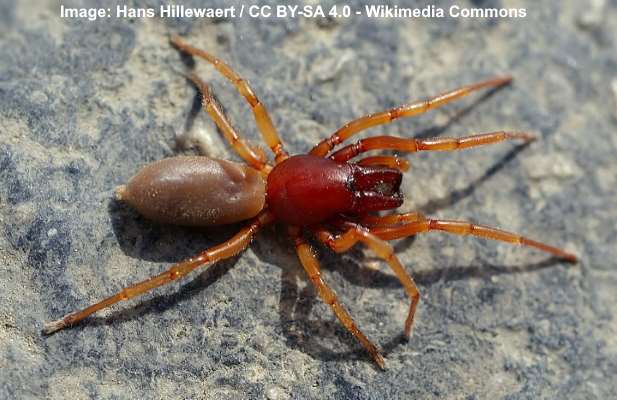
Woodlouse spider (Dysdera crocata)
Biting Mites

Biting mites are tiny arachnids that can cause discomfort and irritation when they bite humans or animals. These mites are usually not visible to the naked eye and require magnification to be seen. Mites in the home can be a sign of vermin infestation. Their bites can cause itching, redness, and small raised bumps on the skin.
Millipedes
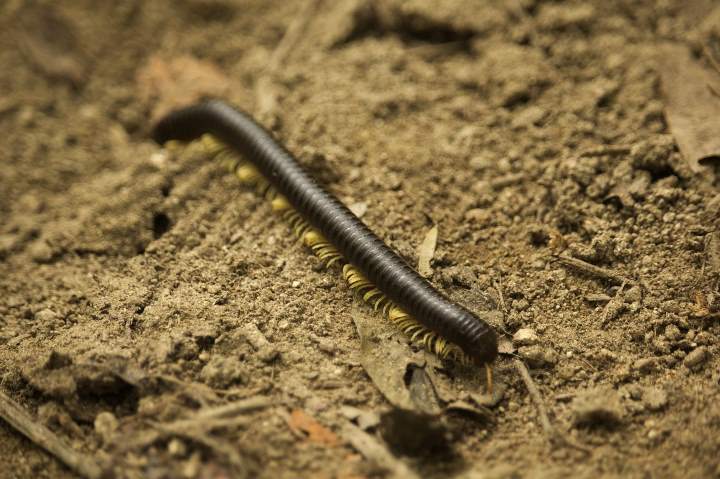
Millipedes are cylindrical arthropods with two pairs of legs per segment. The worm-like creatures can grow 0.08” to 14” (2 – 350 mm) in length, depending on the species. They are typically dark brown or black. You typically find them in damp environments, such as under leaf litter or in rotting logs.
While millipedes are not harmful to humans and don’t bite, some species can release a defensive chemical that may cause skin irritation or allergic reactions in sensitive individuals.
Texas Bug Infestation: Millipedes are dark brown or black worm-like arthropods with a segmented body and two pairs of legs per segment, distinguishing them from centipedes.
Related articles:
